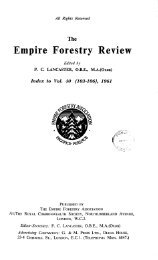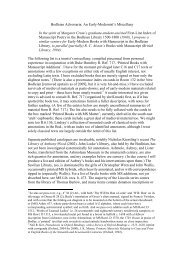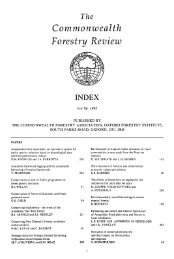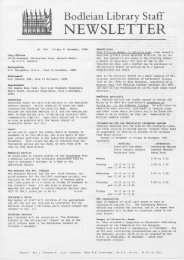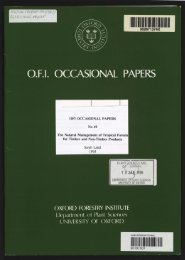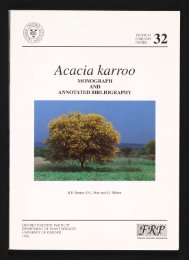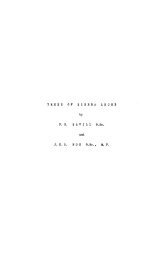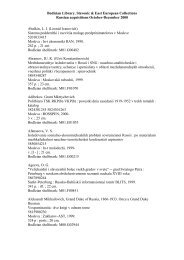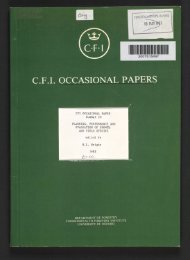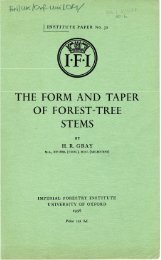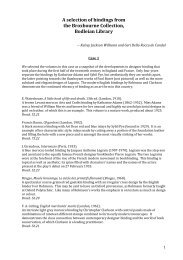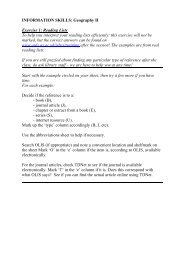Commonwealth Forestry Review
Commonwealth Forestry Review
Commonwealth Forestry Review
You also want an ePaper? Increase the reach of your titles
YUMPU automatically turns print PDFs into web optimized ePapers that Google loves.
Eucalyptus<br />
Coppice for<br />
Chip Material<br />
NOTES AND COMMENTS 9<br />
Satisfactory experiments in the use of this chemical have recently been carried out<br />
at Petawawa Forest Experiment Station. Full details have been written up by J. E.<br />
Brown, Research Officer, Department of Fisheries and <strong>Forestry</strong>, Petawawa Forest<br />
Experiment Station, Chalk River, Ontario.<br />
EXTRACT FROM Forest Products Newsletter No. 376, e.S.I.R.O.,<br />
Melbourne:<br />
With the increasing consumption of wood fibre for the production<br />
of paper, paperboard, fibreboard, and particleboard,<br />
more serious attention is being paid throughout the world to the growing offibre as a<br />
short-rotation crop. There is rising interest in the planting of quick-growing tree<br />
species, the application of fertilizer and irrigation techniques, the utilization of parts<br />
of the tree other than the merchantable bole, and the increased use of waste and<br />
residue material.<br />
Under appropriate conditions eucalypts are capable of rapid growth and can<br />
produce exceptional yields. Many species are able to regenerate by coppicing and the<br />
increment of coppice shoots is higher than that of trees grown from sowing or<br />
planting.<br />
The Division of Forest Products is particularly interested in this problem, and<br />
during 1969 commenced an investigation into the possibilities of using a coppicegrown<br />
eucalypt as a source of chip material. Eucalyptus viminalis was chosen for<br />
study because it has a wide distribution in south-eastern Australia, coppices readily,<br />
and exhibits marked genetic variation.<br />
New Zealand - G. S. BROWN, Local Honorary Secretary, New Zealand, reports<br />
A New <strong>Forestry</strong> plans for the publication of a new journal, New Zealand Journal<br />
Publication of<strong>Forestry</strong> Science, the first number of which is expected to appear<br />
in mid 1971. It will be edited and produced by the Forest Research<br />
Institute, Rotorua. It will be available for a wide range of forestry subjects and to<br />
contributors from the Forest Service, other Government Departments, and industry.<br />
Contributions for the first issue should be submitted by 31 January, 1971 to The Editor,<br />
New Zealand Journal of <strong>Forestry</strong> Science, Forest Research Institute, Private Bag,<br />
Rotorua.<br />
V.A.C.O. DURING THE past few years many items of interest have appeared<br />
Timber <strong>Review</strong> in these columns covering new uses of tropical timbers and in<br />
particular the lesser known or secondary hardwoods of West<br />
Africa. V.A.C.O. Timber <strong>Review</strong> No. 19 published in December gives further information<br />
on the various items already covered. This booklet also reprints a thoughtprovoking<br />
article by Dr. H. C. Dawkins:<br />
The Future of Industrial Cellulose: Unlimited or End in Sight? Not all will<br />
agree with Dr. Dawkins, at the same time his theory commands respect and is<br />
deserving of detailed examination.<br />
This booklet is available from United Africa (Timber) Ltd., United Africa House,<br />
Blackfriars Road, London, S.E.l.<br />
Brachystegia UNITED AFRICA co. (TIMBER) LTD. say that of the less well known<br />
Substitute species of hardwoods that they are currently evaluating in West<br />
for Oak Africa and at Holmes (Wragby) Ltd., Wragby, Lincs., they regard<br />
the species okwen as a most promising example. Although it is<br />
not in the tradition of beautiful woods which many regard as the hallmark of West<br />
African timbers, nevertheless they see a place for it as a substitute for oak.<br />
2



